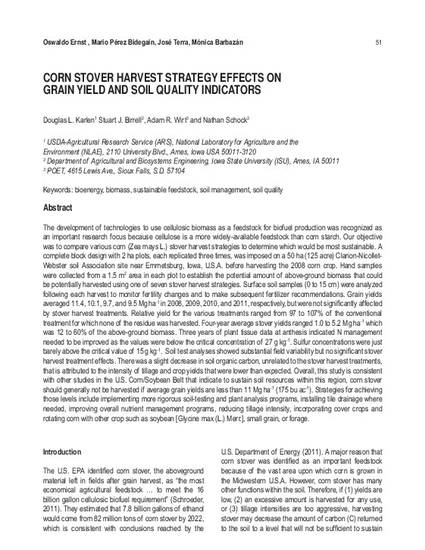
The development of technologies to use cellulosic biomass as a feedstock for biofuel production was recognized as an important research focus because cellulose is a more widely-available feedstock than corn starch. Our objective was to compare various corn (Zea mays L.) stover harvest strategies to determine which would be most sustainable. A complete block design with 2 ha plots, each replicated three times, was imposed on a 50 ha (125 acre) Clarion-Nicollet- Webster soil Association site near Emmetsburg, Iowa, U.S.A. before harvesting the 2008 corn crop. Hand samples were collected from a 1.5 m2 area in each plot to establish the potential amount of above-ground biomass that could be potentially harvested using one of seven stover harvest strategies. Surface soil samples (0 to 15 cm) were analyzed following each harvest to monitor fertility changes and to make subsequent fertilizer recommendations. Grain yields averaged 11.4, 10.1, 9.7, and 9.5 Mg ha-1 in 2008, 2009, 2010, and 2011, respectively, but were not signifi cantly affected by stover harvest treatments. Relative yield for the various treatments ranged from 97 to 107% of the conventional treatment for which none of the residue was harvested. Four-year average stover yields ranged 1.0 to 5.2 Mg ha-1 which was 12 to 60% of the above-ground biomass. Three years of plant tissue data at anthesis indicated N management needed to be improved as the values were below the critical concentration of 27 g kg-1. Sulfur concentrations were just barely above the critical value of 15 g kg-1. Soil test analyses showed substantial fi eld variability but no signifi cant stover harvest treatment effects. There was a slight decrease in soil organic carbon, unrelated to the stover harvest treatments, that is attributed to the intensity of tillage and crop yields that were lower than expected. Overall, this study is consistent with other studies in the U.S. Corn/Soybean Belt that indicate to sustain soil resources within this region, corn stover should generally not be harvested if average grain yields are less than 11 Mg ha-1 (175 bu ac-1). Strategies for achieving those levels include implementing more rigorous soil-testing and plant analysis programs, installing tile drainage where needed, improving overall nutrient management programs, reducing tillage intensity, incorporating cover crops and rotating corn with other crop such as soybean [Glycine max (L.) Merr.], small grain, or forage.
Available at: http://works.bepress.com/douglas_karlen/37/

This article is from agrociencia 16 (2012): 51–55.